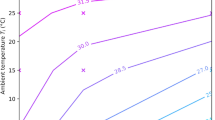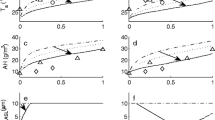Abstract
The nose is the front line defender of the respiratory system. Unsteady simulations in three-dimensional models have been developed to study transport patterns in the human nose and its overall air-conditioning capacity. The results suggested that the healthy nose can efficiently provide about 90% of the heat and the water fluxes required to condition the ambient inspired air to near alveolar conditions in a variety of environmental conditions and independent of variations in internal structural components. The anatomical replica of the human nose showed the best performance and was able to provide 92% of the heating and 96% of the moisture needed to condition the inspired air to alveolar conditions. A detailed analysis explored the relative contribution of endonasal structural components to the air-conditioning process. During a moderate breathing effort, about 11% reduction in the efficacy of nasal air-conditioning capacity was observed.
Similar content being viewed by others
References
Abbott, D. J., F. M. Baroody, E. Naureckas, and R. M. Naclerio. Elevation of nasal mucosal temperature increases the ability of the nose to warm and humidify air. Am. J. Rhinol. 15(1):41–45, 2001.
Becker, W., H. H. Naumann, and C. R. Pfaltz. Ear, Nose, and Throat Diseases: A Pocket Reference. New York: Thieme Medical Pub, 1994.
Cole, P. Biophysics of nasal airflow: A review. Am. J. Rhinol. 14(4): 245–249, 2000.
Cole, P. Further consideration on the conditioning of respiratory air. J. Laryngol. Otol. 67:669–681, 1953.
Cole, P. Some aspects of temperature, moisture and heat relationships in the upper respiratory tract. J. Laryngol. Otol. 67:449–456, 1953.
Daviskas, E., I. Gonda, and S. D. Anderson. Mathematical modeling of heat and water transport in human respiratory tract. J. Appl. Physiol. 69:362–372, 1990.
Eccles, R. Nasal airflow in health and disease. Acta Otolaryngol. 120(5):580–595, 2000.
Elad, D., R. Liebenthal, B. L. Wenig, and S. Einav. Analysis of air flow patterns in the human nose. Med. Biol. Eng. Comput. 31:585–592, 1993.
Elsevier’s Interactive Anatomy: Paranasal Sinuses & Anterior Skull Base, Disc I of Volume 1: The Head & Neck. Available from http://www.elsevier.nl.
Falls, H. B. Exercise Physiology. New York: Academic Press, 1968.
Farley, R. D., and K. R. Patel. Comparison of air warming in the human airway with a thermodynamic model. Med. Biol. Eng. Comput. 26:628–632, 1988.
Ferron, G. A., B. Haider, and W. G. Kreyling. A method for the approximation of the relative humidity in the upper human airway. Bull. Math. Biol. 47:565–589, 1985.
Fox, E., R. Bowers, and M. Foss. The Physiological Basis for Exercise and Sport. Masison: Brown & Benchmark Pub, 1993.
Hahn, I., P. W. Scherer, and M. M. Mozell. Velocity profiles measured for airflow through a large-scale model of the human nasal cavity. J. Appl. Physiol. 75:2273–2287, 1993.
Hanna, L. M., and P. W. Scherer. A theoretical model of localized heat and water vapor transport in the human respiratory tract. J. Biomech. Eng. 108:19–27, 1986.
Hanna, L. M., and P. W. Scherer. Regional control of local airway heat and water vapor losses. J. Appl. Physiol. 61:624–632, 1986.
Hörschler, I., M. Meinke, and W. Schröder. Numerical simulation of the flow field in a model of the nasal cavity. Comput. Fluids 32:39–45, 2003.
Ingelstedt, S. Studies on the conditioning of air in the respiratory tract. Acta Otolaryng. (Stockholm) Suppl. 131:1–80, 1956.
Keck, T., R. Leiacker, H. Riechelmann, and G. Rettinger. Temperature profile in the nasal cavity. Laryngoscope 110(4):651–654, 2000.
Keyhani, K., P. W. Scherer, and M. M. Mozell. Numerical simulation of airflow in the human nasal cavity. J. Biomech. Eng. 117:429–441, 1995.
Lang, J. Clinical Anatomy of the Nose, Nasal Cavity and Paranasal Sinuses. New York: Thiem Medical Pub, 1989.
McFadden, E. R., B. M. Pichurko, H. F. Bowman, E. Ingenito, S. Burns, N. Dowling, and J. Solway. Thermal mapping of the airways in humans. J. Appl. Physiol. 58(2):564–570, 1985.
McFadden, E. R. Heat and water exchange in human airway. Am. Rev. Respir. Dis. 146:S8–S10, 1992.
McFadden, E. R. Respiratory heat and water exchange: Physiological and clinical implications. J. Appl. Physiol. 54(2):331–336, 1983.
Morris, I. R. Functional anatomy of the upper airway. Emerg. Med. Clin. North Am. 6:639–669, 1988.
Naftali, S., R. C. Schroter, R. J. Shiner, and D. Elad. Transport phenomena in the human nasal cavity: A computational model. Ann. Biomed. Eng. 26:831–839, 1998.
Nuckols, M. L., J. L. Zumrick, and C. E. Johnson. Heat and water vapor transport in the human upper airways at hyperbaric conditions. J. Biomech. Eng. 105:24–30, 1983.
Primiano, F. P., Jr., G. M. Saidel, F. W. Montague, K. L. Kruse, C. G. Green, and J. G. Horowitz. Water vapour and temperature dynamics in the upper airways of normal and CF subjects. Eur. Respir. J. 1:407–414, 1988.
Proctor, D. F., and D. L. Swift. Temperature and water vapor adjustment. Respir. Defense Mech. Part I 4:95–124, 1977.
Proctor, D. F. Airborne disease and the upper respiratory tract. Bacteriol. Rev. 30:498–513, 1966.
Proctor, D. F. The upper airways: Nasal physiology and defense of the lungs. Am. Rev. Respir. Dis. 115:97–129, 1977.
Rice, D. H. Rebuilding the inferior turbinate with hydroxyapatite cement. Ear. Nose Throat J. 79(4):276–277, 2000.
Rouadi, P., F. M. Baroody, D. Abbott, E. Naureckas, J. Solway, and R. M. Naclerio. A technique to measure the ability of the human nose to warm and humidify air. J. Appl. Physiol. 87(1):400–406, 1999.
Saidel, G. M., K. L. Kruse, and F. P. Primiano Jr. Model simulation of heat and water transport dynamics in an airway. J. Biomech. Eng. 105:188–193, 1983.
Scherer, P. W., I. I. Hahn, and M. M. Mozell. The biophysics of nasal airflow. Otolaryngol. Clin. North Am. 22:265–278, 1989.
Schroter, R. C., and N. V. Watkins. Respiratory heat exchange in mammals. Respir. Physiol. 78:357–368, 1989.
Subramanian, R. P., R. B. Richardson, K. T. Morgan, and J. S. Kimbell. Computational fluid dynamics simulations of inspiratory airflow in the human nose and nasopharynx. Inhal. Toxicol. 10:91–120, 1998.
Thibodeau, G. A., and K. T. Patton. Anatomy & Physiology, 2nd ed. Mosby, 1993.
Vander, A. J., J. H. Shermann, and D. S. Luciano. Human Physiology: The Mechanisms of Body Function. New York: McGraw-Hill, 1975.
Wolf, M., S. Naftali, R. C. Schroter, and D. Elad. Air-conditioning characteristics of the human nose. J. Laryngol. Otol. 118(2):87–92, 2004.
Author information
Authors and Affiliations
Corresponding author
Rights and permissions
About this article
Cite this article
Naftali, S., Rosenfeld, M., Wolf, M. et al. The Air-Conditioning Capacity of the Human Nose. Ann Biomed Eng 33, 545–553 (2005). https://doi.org/10.1007/s10439-005-2513-4
Received:
Accepted:
Issue Date:
DOI: https://doi.org/10.1007/s10439-005-2513-4




